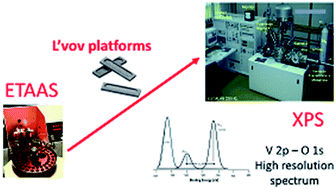XPS characterization of vanadium carbide species formed during the atomization process in electrothermal atomic absorption spectroscopy†
Abstract
Solid state surface phases formed on pyrolytic graphite platforms during the atomization of vanadium in electrothermal atomic absorption spectrometry (ETAAS) have been characterized by means of X-ray photoelectron spectroscopy. Vanadium carbide V8C7, usually denoted as VC in previous literature, has been confirmed as the phase formed at the ashing temperature (1400 °C) and above, while the thermodynamically stable phase under these conditions (V2C) was not observed, suggesting kinetic control in the carbiding process. Some vanadium oxides detected in the XPS analysis are suspected to be an artifact of the technique: particularly VO, a V2+ species produced at the excessively low temperature of 120 °C and probably originating from carbo-reduction favored by irradiation with X-rays. Also, V2O5 is observed after the ashing at 1400 °C, which would be due to reoxidation of the lower V oxides during transfer from the ETAAS equipment to the UHV system. The present results confirm the presence of the “VC” intermediate in the ashing and atomization steps, suggested previously on the basis of inadequate characterization techniques.



 Please wait while we load your content...
Please wait while we load your content...